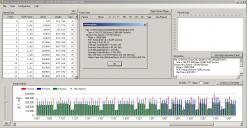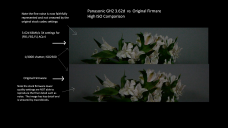
Please, support PV!
It allows to keep PV going, with more focus towards AI, but keeping be one of the few truly independent places.
It allows to keep PV going, with more focus towards AI, but keeping be one of the few truly independent places.
AVCHD maximum image quality settings and testing
-
@towi
Unfortunately, the AQ settings are common for all 1080 modes (high, low, progressive, and interlaced). To preserve a good balance you would have to raise all 1080 modes in the same proportion. That is, if you double 24H, then you should double 24L, FSH and FH as well.
Chris -
well, I've multiplied 24H x4, 24L x3, FSH x2
Last week I've also tried to just double every setting... but then I get the uneven cadence thing (except for FSH/50i) -
Well, you could get some instability with those settings. AQ = 2 would avoid that. Now I wonder which bitrate setting controls the AQ parameters for 1080? Vitaliy?
Chris -
@cbrandin
AQ4 is super for FSH ... 50i has never been exactly great with the GH2 but now it looks really okay!
Of course, also 24H/88Mbps looks great. The files are just somewhat large...
did you ever run a test with my settings?
-
@film_noir try GOP12 instead of GOP24.
-
@towi
...not yet, but I will. First, I want to test my simple settings under more circumstances and see if I can make the uneven cadence happen reliably. If I can't, then I'll start examining the differences between our settings. I haven't tested my settings under enough different environments to be confident that I haven't just been lucky.
Chris -
@cbrandin
"I haven't tested my settings under enough different environments to be confident that I haven't just been lucky."
same here ... the settings need much more testing. Unfortunately at the moment I don't have the spare time to run multiple tests ...
I am looking forward to hearing your findings with my settings! -
OK, I'll give this a try;) : towi, WTF do you mean by 10" ?
-
' = minutes
'' = seconds
for instance 01'30'' is one minute, thirty seconds ... or simply 90''
:-)
-
LOL.. word ;)
-
@cbrandin
Can you post your current settings as a .ini file? I am more than happy to join your testing. -
@cbrandin
My uneven cadence with 88Mbits, 12 gop,AQ3 with everything else untouched.
 88Mbit cadence.JPG1288 x 668 - 165K
88Mbit cadence.JPG1288 x 668 - 165K -
@proaudio4
"I see the improvement in overall detail and low light detail (shadows)."
Can you show us a before/after comparison?
I would like to quote cbrandin:
"Improvements to image quality are readily visible. Absolutely not true."
Maybe a placebo-effect?
-
Enough flaming here people. Stick to the plan.
-
@cbrandin "First, I want to test my simple settings under more circumstances and see if I can make the uneven cadence happen reliably."
Weird, I can make it happen consistently with a static indoor shot that has a reasonable amount of detail (a big pile of my kids toys, cuddly animals etc) at AQ 3 or AQ 4 at 66Mbits and at 44Mbits and 48Mbits. I have only doubled framebuffer settings now, tripling them for 66Mbits didn't make much of a difference, nor did lowering QP. Its predictable in the sense that it will happen eventually within 3 minutes. The shot is lowlit, I don't have NR on and I'm using ISOs in the range of 400 to 800. Writing to a Sandisk Extreme Pro 45MBits card. If it is a buffer fragmentation problem, as I asked ealier, would making the video buffer actually shorter help, as in it would flush it more frequently ? -
@stray
I think I am seeing the same. I have been shooting a pile of clothes yesterday (high texture, indoors, slightly underexposed) and the streamparser graph is really bouncing all over the place after a while. I need to do more testing. I think I will start by shooting the same scene with the stock firmware to see how the default codec settings work. Maybe they show exactly the same behavior. -
@sohus Maybe the camera gets bored of our horribly dull shots and starts dicking about with its encoding strategy to stop itself from falling asleep.
-
@Stray
Actually, I think you're not far off. I can make the cadence thing happen - it doesn't seem to affect IQ - and when something changes (like lighting) the cadence goes back to normal. Theoretically, P and B frames should be able to go almost to zero without affecting static subjects.
Chris -
@cbrandin
Cheers, Interesting, yeah I get your theory it makes a lot of sense to me. Right then, what I'll do tomorrow is go back to an AQ4 set up and shoot both static and moving shots, then I'll try some heavy post work on them. If there is a change in IQ I'll defintely notice it where the cadence change happens. I'll also output the files as a sequence of TIFF files from Premiere CS5.5 and take them into Nuke where I can push them further. If I get the cadence problem during a shot with motion then (as I have done once) then it'll be interesting. However, I do remember the shot in question that did that was a camera movement, and not an actually motion within the subject. Sooo.. I guess it's possible that as the camera is recording a hell of a lot more data than it does normally it really doesn't need the frames to remain as high as they were to maintain IQ consistency. I like this theory, maybe it also explains how a lower GOP causes it more consistently, as the I frames themselves (containing much more data in themselves) are more frequent. But then again I frames are encoded stand alone without reference to any B or P frames right ? -
Another thought, which backs up your theory, the moving shot I had where the cadence problem emerged was a shot I made while walking. The cadence problem started as I paused for a second and slowly panned (much less movement). Unfortunately the cadence didn't get back to normal till a good few seconds into me moving the camera at the initial speed again. This shot was at AQ2, its why I'm currently shooting with AQ1.
-
@Angry_C>"Can you show us a before/after comparison?
@Angry_C>"Maybe a placebo-effect?"
Yes I can.
It's high ISO 2500. This test really shows how well 3.62d 66Mb/s AQ4 can really resolve fine detail such as noise.
Also, the flower pedals show more detail.
And Yes, Chris is right. It's not always easily visible, especially in static shots. But throw it on your timeline and
start grading and you will see who causes the most issues.
Also, let's face it, the GH2 stock firmware looks great! Afterall, this excellent image quality is what sold us in the first place.

 362d vs original firmware.png1920 x 1080 - 2M
362d vs original firmware.png1920 x 1080 - 2M -
Thanks Vitaliy. I just uploaded the PNG file.
-
Thank you! Great example of the huge improvement in the codec.
-
@proaudio4
thanks for the test!
In my opinion, this is 100% definitive. I was expecting to see better reproduced noise, but I wasn't expecting to see a visibly sharper image with finer detail. And god is that grain sexy:) bye bye macroblocks:)
One word, astonishing! -
@proaudio4 so x3 with no gop changes? this is interesting... trying it out right now. I have been in the middle of a shoot this week and last but with rain delays, ill even switch up mid shoot if its worth it!! The png is very promising indeed, thank you! i actually went stock due to so many inconsistency in my tests and reports here =(
This topic is closed.
← All Discussions Start New Topic


Howdy, Stranger!
It looks like you're new here. If you want to get involved, click one of these buttons!
Categories
- Topics List23,993
- Blog5,725
- General and News1,354
- Hacks and Patches1,153
- ↳ Top Settings33
- ↳ Beginners256
- ↳ Archives402
- ↳ Hacks News and Development56
- Cameras2,368
- ↳ Panasonic995
- ↳ Canon118
- ↳ Sony156
- ↳ Nikon96
- ↳ Pentax and Samsung70
- ↳ Olympus and Fujifilm102
- ↳ Compacts and Camcorders300
- ↳ Smartphones for video97
- ↳ Pro Video Cameras191
- ↳ BlackMagic and other raw cameras116
- Skill1,960
- ↳ Business and distribution66
- ↳ Preparation, scripts and legal38
- ↳ Art149
- ↳ Import, Convert, Exporting291
- ↳ Editors191
- ↳ Effects and stunts115
- ↳ Color grading197
- ↳ Sound and Music280
- ↳ Lighting96
- ↳ Software and storage tips266
- Gear5,420
- ↳ Filters, Adapters, Matte boxes344
- ↳ Lenses1,582
- ↳ Follow focus and gears93
- ↳ Sound499
- ↳ Lighting gear314
- ↳ Camera movement230
- ↳ Gimbals and copters302
- ↳ Rigs and related stuff273
- ↳ Power solutions83
- ↳ Monitors and viewfinders340
- ↳ Tripods and fluid heads139
- ↳ Storage286
- ↳ Computers and studio gear560
- ↳ VR and 3D248
- Showcase1,859
- Marketplace2,834
- Offtopic1,320









